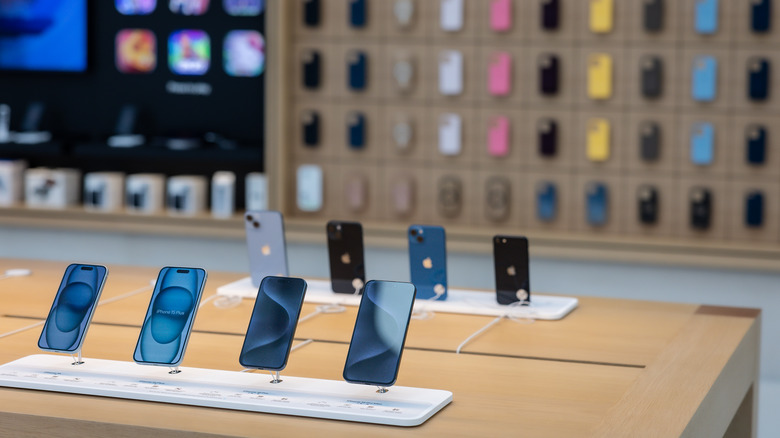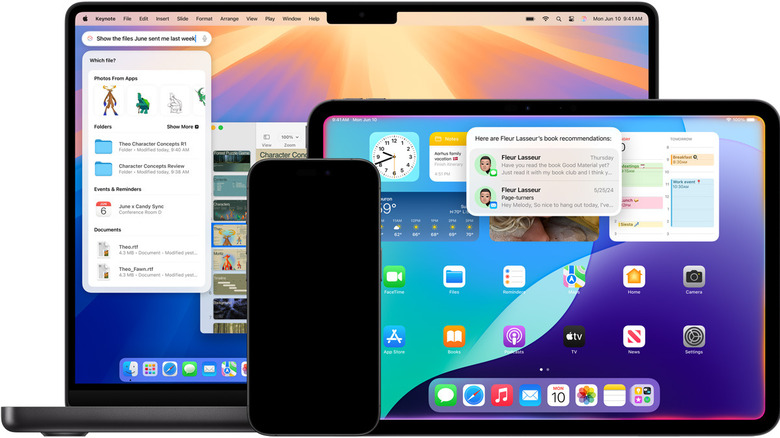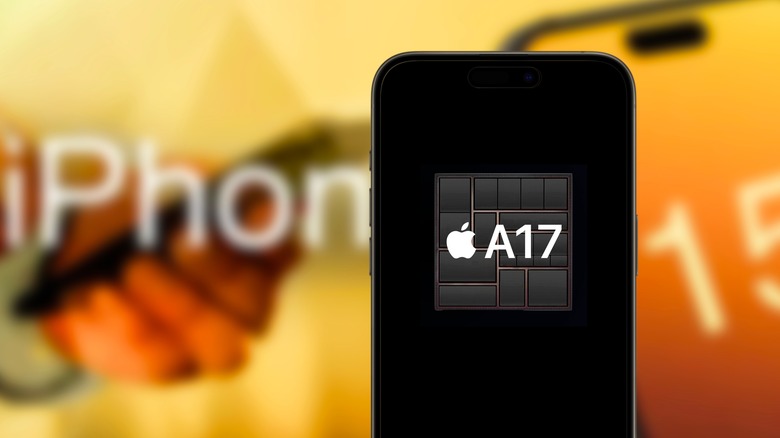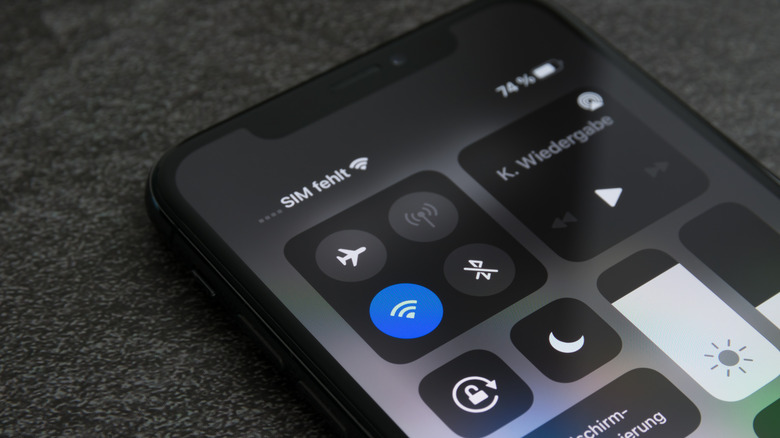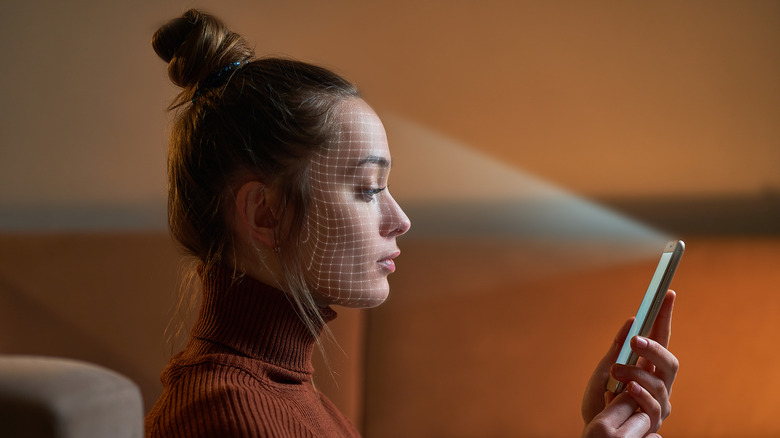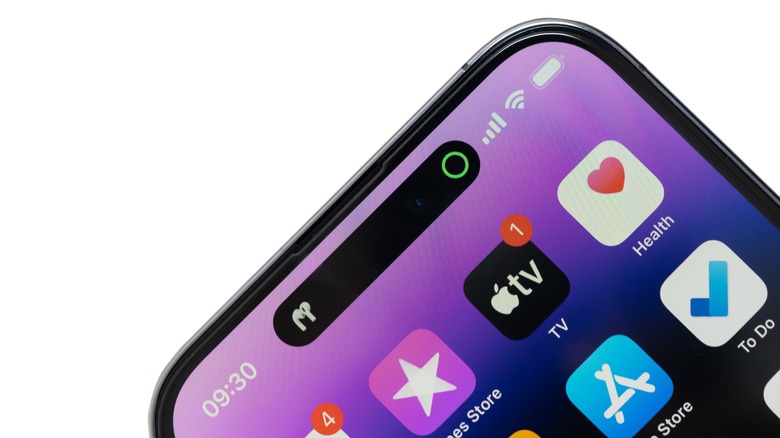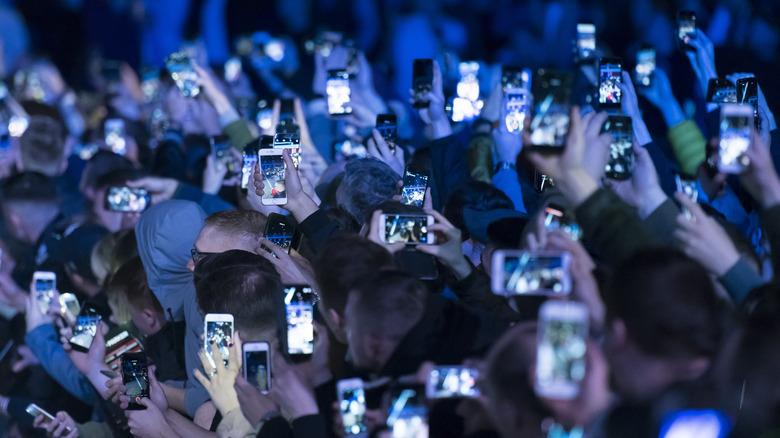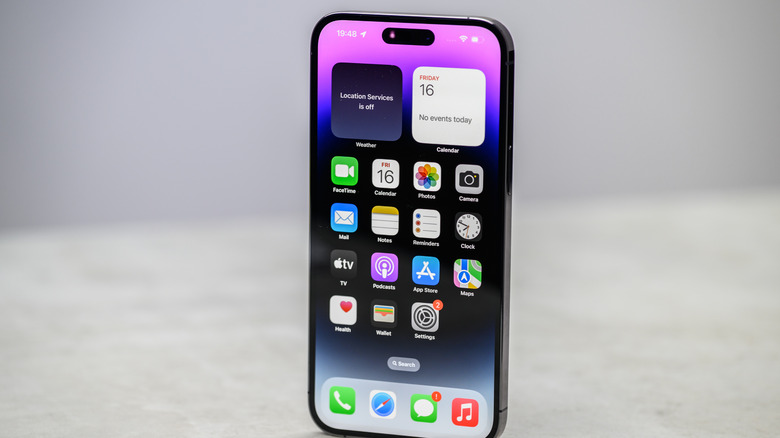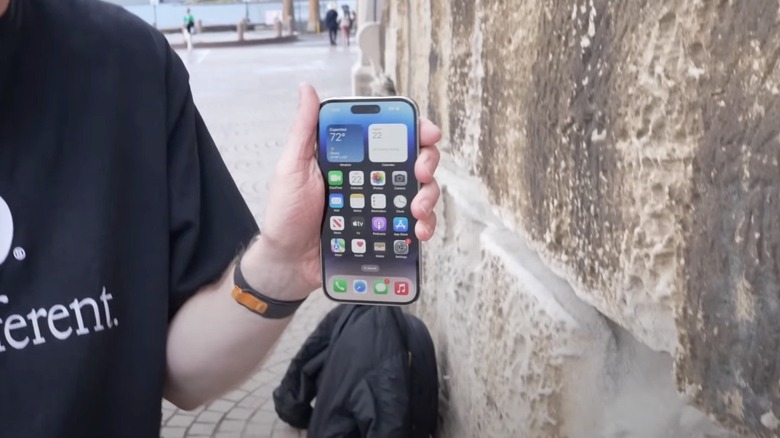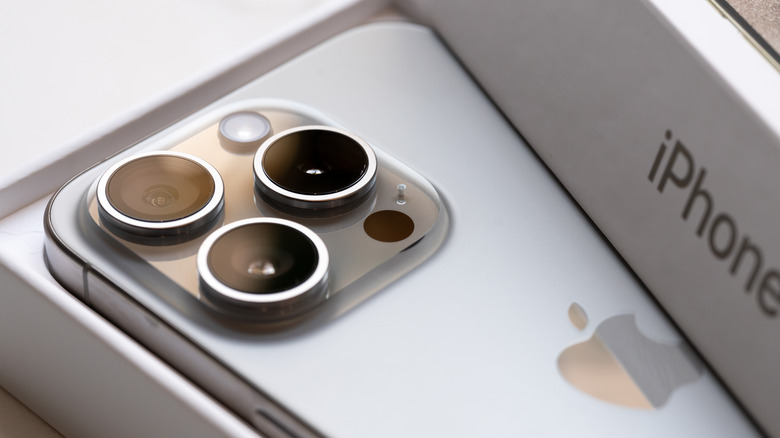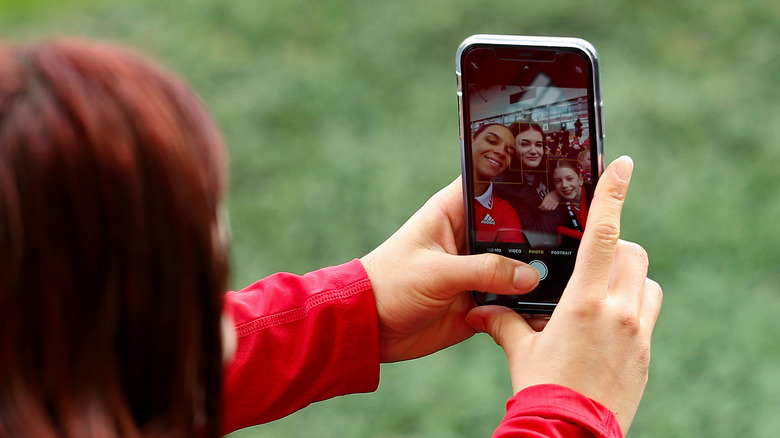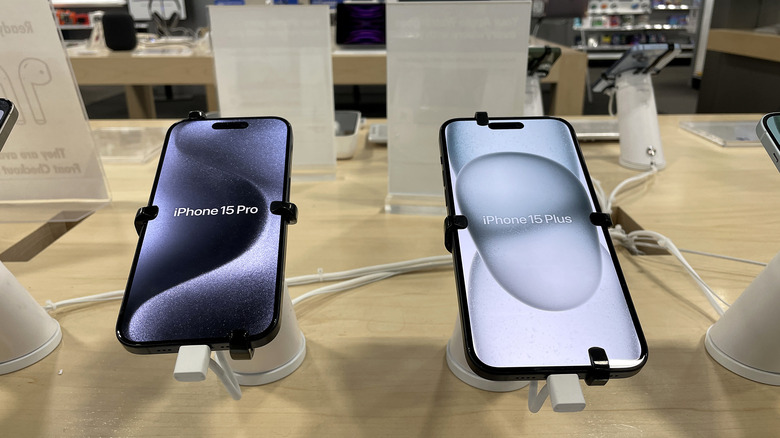Thinking Of Upgrading To The iPhone 16? Here's Why You Should Wait For The 17
Let's be real: smartphones aren't new and exciting anymore. A decade ago and beyond, every iteration in a brand's lineup was exponentially better than the previous. Fast forward to today, and the average person wouldn't be able to tell the iPhone 15 Pro from the iPhone 14 Pro, even side-by-side — the 13 Pro or 12 Pro would look identical at a glance. It's gotten to the point where there's not much use replacing a phone each year in the hopes the next version will be better. Improvements have become marginal, and most folks can get a new-phone experience just by replacing their battery. The 2025 iPhone 17, however, might be a rare exception — emphasis on might.
The iPhone 16 is slated to release around September 20th, 2024, according to predictions listed in Forbes. If the rumors are true, there's nothing special about it. The biggest anticipated change is a new camera shutter button. Still, people are probably going to buy it in fairly large numbers because all iPhone 16 models support Apple Intelligence. Currently, only iPhone 15 Pro owners get that privilege.
It may be worthwhile to hold off. The iPhone 17 family might make a large enough leap forward over its predecessor that you'd be kicking yourself for buying the 16. In the interest of full disclosure, everything we say here is based entirely on unconfirmed leaks, rumors, and hearsay. But if you've got your eye on the iPhone 16, here are 11 reasons you might wait until 2025 for the 17.
Apple Intelligence won't be fully available until 2025
You heard that right. The marquee feature meant to drive iPhone 16 sales will not be present on release day. Not a single Apple Intelligence feature drops until iOS 18.1 in October — and on that date, you'll only get a fraction of what you saw at WWDC 2024. The iOS 18.1 includes things like Writing Tools (to rewrite or summarize text), visual upgrades to Siri, Mail summaries and smart replies, transcription summaries, and a few extra nuts and bolts.
Notice how there's no Genmoji, Image Playground, or the supercharged Siri we saw at WWDC? That's not your eyes playing tricks on you. Apple Intelligence will be rolling out piecemeal through this year and into the next. It's hard to say when exactly each new feature will arrive, but according to Mark Gurman, the king of Apple leakers, the biggest one — Siri 2.0 — won't appear until Spring 2025 as part of iOS 18.4. For reference, iOS 17.4 didn't release until March 2024. And all of this is for U.S. English; it's impossible to say when other English regional varieties and languages will get their turn.
In short, a pivotal reason to grab the 16 will only be functional in its entirety almost a year after release. Sure, these features will be in beta before then — and several are now — but it's not worth risking a critical bug with your daily driver. If you can wait until March 2025, why not wait until September 2025? For a phone that starts at $800 (perhaps more if there's a price hike) biding time seems like the smart move here.
Is there more RAM?
Apple's decision to limit its Intelligence features to the iPhone 15 Pro was a controversial decision to say the least. It felt like a money grab to force customers to upgrade. While you won't find Apple losing any sleep about making more money, there was a method to its madness. Apple Intelligence uses an on-device LLM (large language model, like ChatGPT) rather than one based in the cloud. This is a resource-intensive process that earmarks between 0.7 and 1.5GB of RAM, according to Ming-Chi Kuo. Thus, an iPhone needs at least 8GB of RAM to keep Apple Intelligence idling and ready-to-go without bogging down your phone. Only the iPhone 15 Pro has 8GB of RAM; the 14 Pro and below carry six or less.
8 GB of RAM is going to be plenty for most people, but again, iPhones start at $800. A $500 Google Pixel 8a has the same amount of RAM for almost half the price. The Galaxy S24 Ultra carries 12GB of RAM, compared to the similarly-priced 15 Max's 8GB. With apps being as weighty as they are these days, you want as much breathing room as possible when Apple Intelligence effectively makes almost a fourth of your RAM inaccessible — another reason you should wait for the 17.
The 16 Pro will likely only have 8GB of RAM, again. The 17 Pro, on the other hand, may finally come with 12 GB of RAM, according to MacRumors. If you feel like your phone struggles with its RAM configuration, consider waiting.
A faster, more efficient in-house modem
Apple's decision to go with proprietary Apple Silicon instead of Intel was a game changer. The arm64-based chips allow for insane battery life on fanless laptops that can still crush demanding workloads. The lesson was this: if you design hardware in-house, custom-built for your software, you reap more performance and efficiency gains than working your software around someone else's hardware. Rumors have been floating around for a while that Apple is working on a proprietary modem (WiFi and Bluetooth chip) for its phones. The iPhone 17 may feature it when such a chip arrives.
According to MacRumors, the 17 may have a custom-made Wi-Fi 7 chip (no Bluetooth) that allows for a more reliable connection with high speeds and minimal latency. Apple seems to be slowly parting ways with Broadcom, the manufacturer that makes its connectivity chips.
It's impossible to say how this chip will perform over a year ahead of the iPhone 17 launch. If the Apple Silicon revolution is any indication, your phone might have a rock-solid, blistering fast connection that only nibbles at your battery. If you've had spotty connections, or been unimpressed with your connection speed and performance, the iPhone 17 might be worth a wait.
What about under-display Face ID?
The notch and dynamic island are pretty roundly disliked by those who are used to Android, where the camera is only a small punch hole in the screen. Alas, that's the price you pay for Apple's class-leading Face ID. It takes a whole retinue of sensors to quickly and accurately scan your face, and those sensors take up a lot of space. Under-screen cameras are yet to appear on flagship smartphones, but Apple may incorporate under-screen Face ID in the iPhone 17.
This rumor comes courtesy of Ross Young, who posted on X (formerly Twitter) his predictions for future screen and notch technologies. In the graphic, he predicts that the iPhone 17 Pro will be the first to get an under-panel Face ID with only a hole for the selfie camera.
For some, this could be huge. Imagine how much more screen real estate you'd get back. Perhaps Apple will use the space for a better notification system, one of the many things it falls behind on compared to Android. At the very least, it's cool technology to authenticate your identity with a set of sensors that aren't visible.
There's a smaller dynamic island
Since everything we're discussing here is firmly in the realm of rumor, there are occasionally conflicting rumors. One is that rather than under-screen Face ID, we'll instead get a smaller dynamic island. The dynamic island turned out to be an incredibly clever way to hide the Face ID/camera cutout with background processes like timers and music. Still, it couldn't obscure just how big the island is, especially when it leaves a gaping black pill during video playback or when playing a game. If we don't see its complete removal with an under-screen Face ID, then we may at least see a size reduction.
Jeff Pu (an Apple analyst) suggests we'll get a narrower dynamic island on the iPhone 17 Pro Max, MacRumors reported. It would achieve this thanks to a so-called "metalens." According to nature communications, a metalens uses small "nanoantennas" to redirect light, rather than a convex refractive lens seen in most applications. So, it would appear that the metalens could be smaller than traditional refractive lens while still producing the same amount of light, thus shrinking the dynamic island without hindering Face ID. Since the dynamic island hasn't shrunk since the iPhone 14 Pro (and seemingly won't for the iPhone 16) you'll be glad you waited if this is a particular pet peeve of yours.
120Hz displays across the board
120Hz screens are swiftly becoming the bare minimum on Android nowadays, and for good reason. A 120Hz panel makes swiping through your phone silky smooth and responsive, so much so that it's painful to scale back down to 90Hz or, God forbid, 60Hz. You can find this high refresh rate even on $200 budget devices like the Nothing CMF Phone 1. You won't find it on the iPhone 15 at $800. Apple loves to rebrand existing features, so ProMotion (120Hz displays) are only on the $1,000 iPhone 15 Pro and above. If you thought that trend might be changing for the 16, you thought wrong. The iPhone 16 will likely have the exact same 60Hz refresh rate as it's had since the very beginning with the original 2007 iPhone. That appears to be changing for the iPhone 17.
Ross Young, who predicted that the iPhone 17 Pro may have an under-display Face ID, also suggested in his graphic that Apple's LTP0 panels (read: 120Hz) may come to the normal baseline iPhone 17. That's not all. This would probably mean that you'd finally have Always-on displays even for the cheapest iPhone. And since LTP0 displays allow for a variable refresh rate, your iPhone would save battery by dynamically gearing down to a low refresh rate whenever possible. If you never buy the Pro iPhones, then this is one of the bigger features worth waiting for.
We could see bigger displays
For most people, smartphone displays are plenty big these days, and phone manufacturers have more or less settled on a standard of about six inches, with larger phones sitting around seven. For some out there, there's no such thing as too much OLED, and they'll take as much screen real estate as a manufacturer will throw at them. The 16 Pro is bringing a larger 6.3 and 6.9-inch display size, but it's very common for Pro features to make their way to future entry-level iPhones. In this case, those slightly larger display sizes are anticipated (rumor indicates) to trickle down to the normal 17s — so if you're all for the biggest screen possible, but not huge on Pro iPhones, this one's for you.
This leak comes, again, from Ross Young via MacRumors. To be clear, this is a very, very small size increase; you're only getting about 2.5% more screen. You'd probably only notice that difference when holding the 16 and 17 side-by-side, and even then we're talking a difference of millimeters. If you're paying $800 for a phone, though, you probably want as much "phone" as you can get.
More scratch and reflection-resistant displays
Another area that smartphone manufacturers have more or less perfected is the screens themselves. Most phones have to be dropped from pretty high up before their screens will crack, and even higher still before that cracked screen stops working. Then came the iPhone 15 Pro with its titanium edges, meant to make the phone both stronger and lighter. Sam Kohl of AppleTrack on YouTube did a drop test comparing the iPhone 15 Pro and its 14 Pro predecessor, and discovered that while the newer device was lighter, it definitely wasn't stronger.
The 15 Pro's back glass began to crack in one of the early drops and its screen became unusable during a more extreme 15-foot drop. Meanwhile, the 14 Pro suffered cosmetic damage only in later drops, and even survived (as in, was fully functional) a 20-foot drop. We can only guess why the 15 failed so miserably, but some speculate that harder titanium metal does a poorer job of dispersing the shock compared to softer aluminum — thus putting it all into the screen instead.
Keeping all that in mind, we may have reason to hope the 17 will feature a more scratch-resistant and less reflective display, according to MacRumors. The leak originates from Instant Digital, a Chinese leaker. A display that is more scratch resistant, we hope, could increase durability on seemingly fragile titanium phones — assuming Apple doesn't just ditch titanium altogether.
48MP Telephoto lens for detailed long shots
The telephoto lens on the iPhone 15 Pro Max is a brilliant little piece of engineering that forgoes Samsung's periscope in favor of a tetraprism. Although only 5x, it's certainly better than a grainy digital zoom on previous models. The quality on these telephoto shots depends in no small part on the size of the sensor. So in that spirit, the iPhone 17 Pro Max may be the first of its breed with a 48-megapixel telephone lens, MacRumors notes.
What's great about this is that because of the higher pixel density, pictures will retain more detail. More detailed shots make up for the lack of additional magnification since you can enlarge and crop the image without turning it into a blurry, pixelated mess. So even though the prism only allows for 5x zoom, you might be able to crop a picture that looks like you'd zoomed even further. This would make the iPhone 17 Pro Max the first to have 48 megapixels on all its cameras, too.
24MP selfie cam for detailed selfies
The selfie cam on the iPhone has always been good enough, especially when you use it for FaceTime video calls. Of course, it could always be better. If you're one of those people that has a photo library filled to the brim with selfies, then listen up. The 17 series may finally upgrade that aging 12 megapixel lens to a 24 megapixel one. This leak originates again from Ming-Chi Kuo, the guy who explained the memory requirements for Apple Intelligence.
Increased pixel density means, naturally, you'll get much higher quality pictures that won't lose as much detail if you crop them. FaceTime calls will likely get even sharper, although they will consume more data as a consequence. In any case, this is a noteworthy change since the selfie camera has been 12 megapixels since the iPhone 11. It probably won't be a night and day difference for the general populace, but avid selfie-takers will want to be first in line for this feature.
The unveiling of the iPhone Slim
There have been whisperings for sometime that Apple was going to release an even higher-end, more premium model of iPhone, dubbed the iPhone Ultra. More recent rumors suggest that the ultra part of the moniker may refer to the device being ultra-slim — like the M4 iPad Pro. According to MacRumors, this hypothetical iPhone Slim would replace the Plus and cost more than the Pro Max while being one of the thinest — if not the thinnest — devices in Apple's history.
The only real potential benefit of this slim iPhone is that, well, it would be thin — the leaks all suggest it would have no hardware advantages over its iPhone siblings. To distinguish it, Apple might give it a camera bar like the Google Pixel, rather than a camera box seen in iPhones for years now. Being thinner, it could likely be much lighter and therefore appeal to someone tired of all that pinky fatigue. Though keep in mind, the Slim-related rumors are all very vague and often conflicting, especially so far from the release date of this hypothetical product. If you want an exceptionally light phone and loved the M4 iPad Pro's impossible thinness, then waiting for the 17 series might be a good idea.
Should you wait for the iPhone 17 series?
Everything we discussed boils down to one question: should you wait? As with all things in life, it depends. Suppose you have an iPhone that's already three to five years old, and while you might be eyeing an upgrade, the phone still gets the job done without too much of a headache. In that case, just wait. Your iPhone will continue to receive security updates; even the iPhone XR from 2018 — a six-year-old phone, to be clear — is getting the upcoming iOS 18.
The hardware upgrade of the 17 will probably feel like a more significant spec bump the older your phone is, and some have speculated that the iPhone 17 could be the biggest iPhone refresh since the iPhone X in 2017. There may be even more improvements in the offing. We're still over a year away from the iPhone 17's release, so coming leaks may further confirm the 17 to be a big one.
That said, these improvements we've mentioned are all incremental at best. They're rumors, and prior to every iPhone release a fair amount of them get proven wrong. Not a single improvement is going to turn your world upside down, anyway. If you cave and buy the 16 this September, you'll probably experience very minimal regret when the 17 comes out next year. So if your phone is unbearably sluggish and goes catatonic when multitasking between apps, grab the 16. You'll probably be glad you did, and you'll likely be included in most upcoming Apple Intelligence features for years to come.
